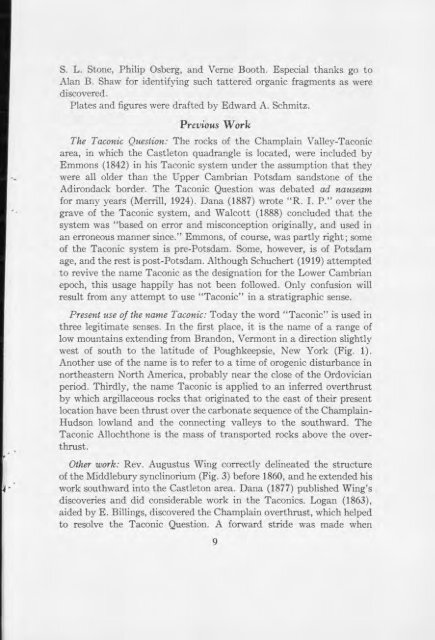STRATIGRAPHY AND STRUCTURE CASTLETON AREA VERMONT
STRATIGRAPHY AND STRUCTURE CASTLETON AREA VERMONT
STRATIGRAPHY AND STRUCTURE CASTLETON AREA VERMONT
You also want an ePaper? Increase the reach of your titles
YUMPU automatically turns print PDFs into web optimized ePapers that Google loves.
S. L. Stone, Philip Osberg, and Verne Booth. Especial thanks go to<br />
Alan B. Shaw for identifying such tattered organic fragments as were<br />
discovered.<br />
Plates and figures were drafted by Edward A. Schmitz.<br />
Previous Work<br />
The Taconic Question: The rocks of the Champlain Valley-Taconic<br />
area, in which the Castleton quadrangle is located, were included by<br />
Emmons (1842) in his Taconic system under the assumption that they<br />
were all older than the Upper Cambrian Potsdam sandstone of the<br />
Adirondack border. The Taconic Question was debated ad nauseam<br />
for many years (Merrill, 1924). Dana (1887) wrote "R. I. P." over the<br />
grave of the Taconic system, and Walcott (1888) concluded that the<br />
system was "based on error and misconception originally, and used in<br />
an erroneous manner since." Emmons, of course, was partly right; some<br />
of the Taconic system is pre-Potsdam. Some, however, is of Potsdam<br />
age, and the rest is post-Potsdam. Although Schuchert (1919) attempted<br />
to revive the name Taconic as the designation for the Lower Cambrian<br />
epoch, this usage happily has not been followed. Only confusion will<br />
result from any attempt to use "Taconic" in a stratigraphic sense.<br />
Present use of the name Taconic: Today the word "Taconic"is used in<br />
three legitimate senses. In the first place, it is the name of a range of<br />
low mountains extending from Brandon, Vermont in a direction slightly<br />
west of south to the latitude of Poughkeepsie, New York (Fig. 1).<br />
Another use of the name is to refer to a time of orogenic disturbance in<br />
northeastern North America, probably near the close of the Ordovician<br />
period. Thirdly, the name Taconic is applied to an inferred overthrust<br />
by which argillaceous rocks that originated to the east of their present<br />
location have been thrust over the carbonate sequence of the Champlain-<br />
Hudson lowland and the connecting valleys to the southward. The<br />
Taconic Allochthone is the mass of transported rocks above the overthrust.<br />
Other work: Rev. Augustus Wing correctly delineated the structure<br />
of the Middlebury synclinorium (Fig. 3) before 1860, and he extended his<br />
work southward into the Castleton area. Dana (1877) published Wing's<br />
discoveries and did considerable work in the Taconics. Logan (1863),<br />
aided by E. Billings, discovered the Champlain overthrust, which helped<br />
to resolve the Taconic Question. A forward stride was made when













